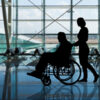The prospect of travelling long distance, sometimes leads to elevation of health issues. As air travel gets cheaper, the airports and the terminals are getting crowded by the day.
Flying by air is considered as one of the safest mode of travel. When making travel plans, which involve children and elderly, it is extremely important to keep the details of an air ambulance services provider handy. One of the common symptoms or medical condition seen while in flight is DVT or ‘Deep Vein Thrombosis.’ Let’s read a little more about it.
- What Is DVT?
DVT is generally caused due to long hours of no or little activity. Small blood clots are sometimes formed in the feet and the legs. They are harmless in most people. But can pose a health risk for people suffering from heart diseases, cancer, pregnancy or a recent injury.
- Why Does It Happen?
Some experts disagree about any certain relation between DVT and air travel. Airlines have limited space and the cabin crew generally discourages moving around. The long hours of immobility causes DVT. The air at high altitude is also very dry and adds to the trouble.
- The Symptoms of DVT?
The symptoms may not be visible immediately and may get highlighted once you reach home or embark from the plane. It may start with pain in the calves and get worse every passing hour. The area of pain may also show swelling and redness. In some cases the clots may also get blue. If the traveler sees any such symptoms he should consult a doctor immediately.
- How to Avoid DVT?
If you have no allergy to aspirin, take a small dose of it before you board the flight. Always wear comfortable and loose clothing while travelling. Avoid crossing your legs for long durations. If possible walk up and down the aisle after every hour or so. Keep yourself hydrated by having water.
- Inform Your Doctor
Discuss your travel plans with your doctor and revise all medications with him for travel. Stay calm and enjoy the flight.











